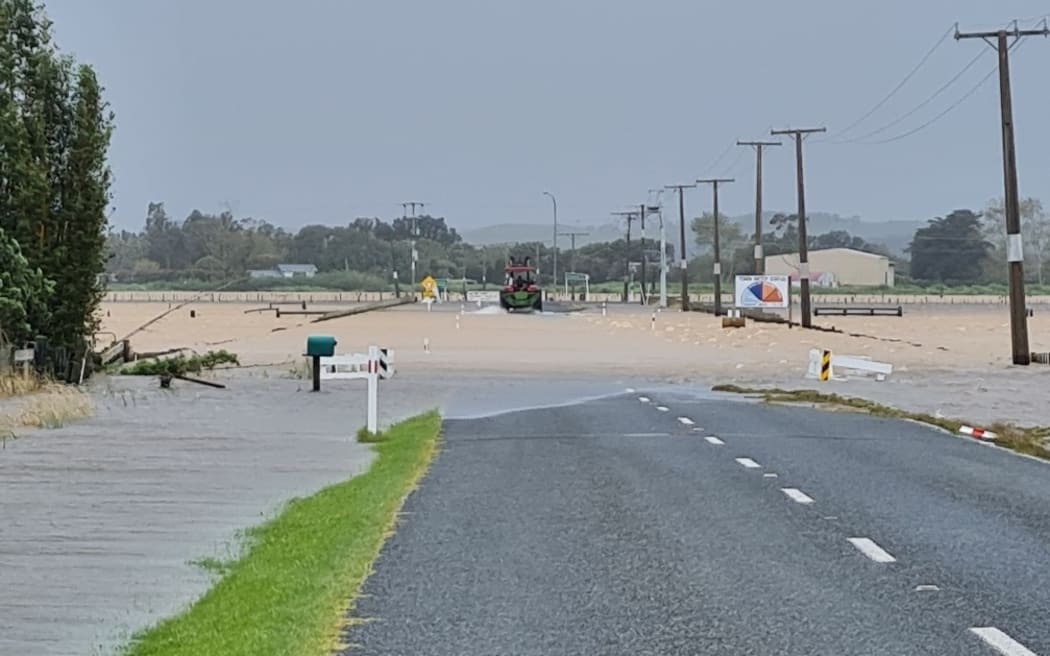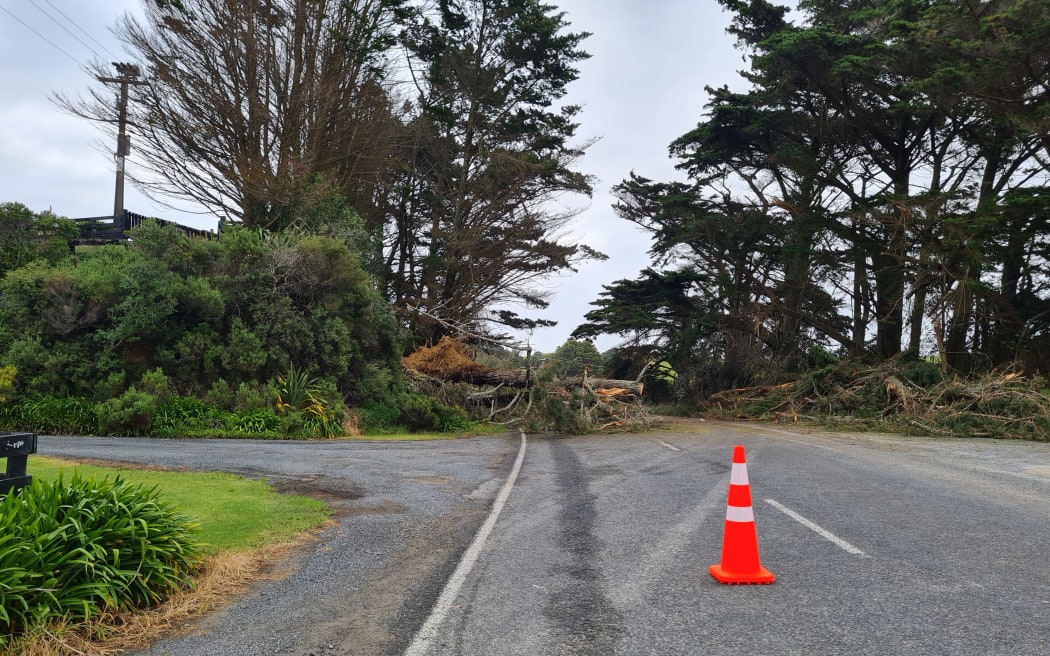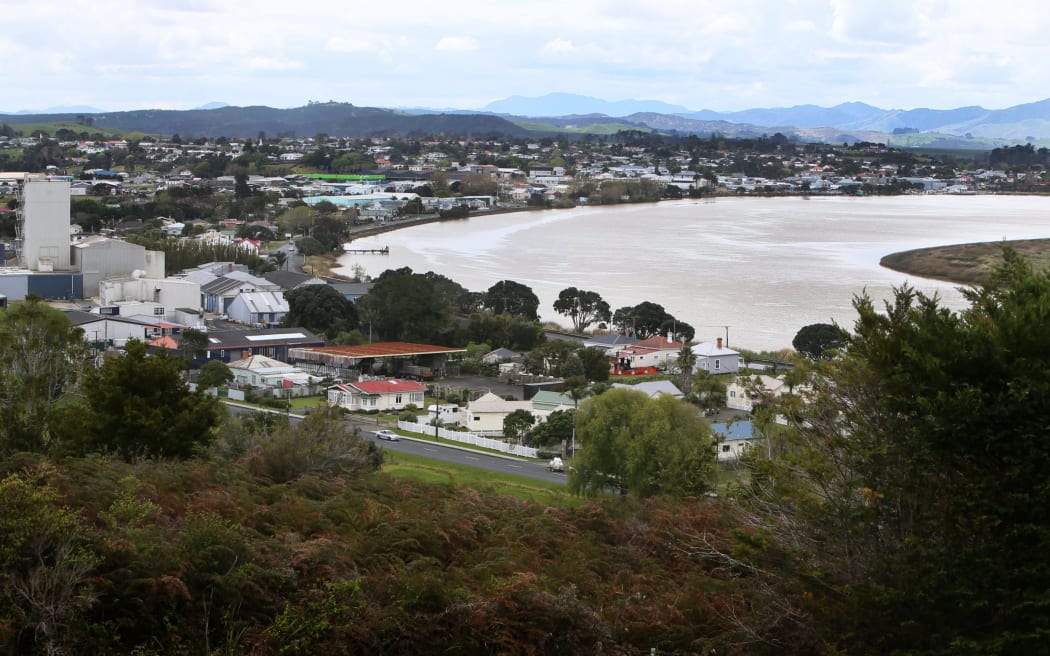
The road from Baylys Beach to Dargaville in Northland flooded on Tuesday.
Photo: RNZ/ Mick Hall
The sun finally came out over Northland on Wednesday after the region was rocked by Cyclone Gabrielle. Dargaville has been one of the worst hit towns, and despite the fresh evacuations, some in other areas of town have been allowed to return home.
Kaipara District Council said Mangawhare residents who live along River Road, and Victoria and Logan Streets, as well as side streets and Finlayson Park Avenue are strongly advised to leave oon Wednesday afternoon.
Peak flows were expected this evening and there was a risk of flooding from 6pm until 8am Thursday morning.
Shelter is available at the Anglican Church in Hokianga Street.
On Sunday, Reverend Frank Nelson was approached to open his church as an evacuation centre.
He said 20 people slept in the Holy Trinity Anglican Church last night, and as many as 80 were being sheltered at the storm’s peak.
“People are working together wonderfully,” he said. “People arrive, pot of soup, a fresh batch of muffins, people phoned up and said they’d bring breakfast.”
Nelson said the evacuations came as a shock.
“A lot of the people who are here are just stunned, they never expected to have to move,” he said.
The church quickly filled up, and the council moved to open two more centres.

A downed tree on Baylys Beach Road, 9km west of Dargaville, Tuesday 14 February.
Photo: RNZ / Michael Hall
Antony Thompson of Te Rūnanga o Ngāti Whātua said his iwi had been helping people throughout Northland, but Dargaville became the priority.
“The evac centre filled up really quick, over at the church,” he said. “So we opened up one of our sites at Ngāti Whātua, and we took in about 25 to 30 whānau.”
Thompson said he was grateful so many people in the region were prepared for the cyclone.
“Yes we’ve been impacted heavily along our marae areas, but because of the previous floods a lot of Aucklanders and a lot of our whānau have been prepared,” he said.
“So yes, they were without power. Yes, without phones. But they had their go packs, which were really successful.”
Despite that preparedness, the extent of the damage was vast and the recovery will be long.

ACE Rentals in Dargaville have been delivering excavators and sweepers through the night to help clear storm damage, but the company’s yard flooded with the heavy rain.
Photo: Supplied/ ACE Rentals
Dairy and kūmara farmer Graham Lawrence said the cyclone was devastating.
“Most of our farm’s gone under,” he said. “We’ve got, probably about 80 percent of the farm has been underwater.”
That was adding insult to injury, he said, after having already faced a challenging growing season.
“The whole kūmara area of Dargaville has been heavily affected, it was already half the volume anyway because of the conditions,” he said. “So there are going to be some huge shortages.”
Lawrence was trapped in his home by floodwaters for two days.
“Our driveway was a metre underwater, so we were isolated,” he said. “The milk tanker hasn’t been able to come in, so I had to dump yesterday’s milk.”

The Northern Wairoa river flowing past Dargaville.
Photo: LDR / Northern Advocate / Tania Whyte
The sun came out today, but Lawrence said it was a double-edged sword. The silt that now covered his farm would dry, and his crops would suffocate.
“The sun’s come out and things are drying,” he said. “But then, it also bakes the silt to the grass which creates another problem, that the plant can’t get the sunlight.”
“The silt baked on the plants will make the plants rot.”
Others were excited to see the storm move on. When the sun came out this morning, Reverend Nelson said it was like being transported to another world.
“There’s a surprisingly good mood, the wind has dropped and the sun is shining,” he said. “It’s a different world, it’s hard to believe the change, actually.”
“People will be out, tidying up, mopping up.”
The Kaipara District Council said the emergency centre would remain open for those who needed it.




